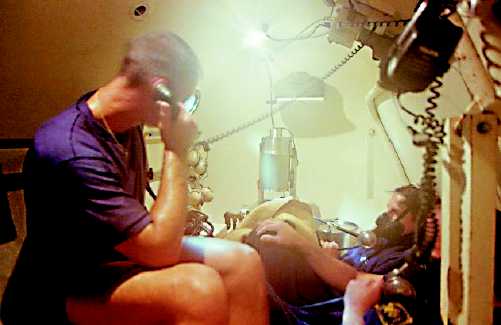8-36 Change A
U.S. Navy Diving Manual—Volume 2
6.
While ascending and during the decompression stops, the diver must be
satisfied that no symptoms of physical problems have developed. If the diver
feels any pain, dizziness, or numbness, the diver immediately notifies topside.
During this often lengthy period of ascent, the diver also checks to ensure that
his umbilical is not becoming fouled on the stage line, the descent line, or by
any steadying weights hanging from the stage platform.
7.
Upon arrival at the surface, topside personnel, timing the movement as
dictated by any surface wave action, coordinate bringing the stage and
umbilical up and over the side.
8.
If the diver exits the water via the ladder, the tenders provide assistance. The
diver will be tired, and a fall back into the water could result in serious injury.
Under no conditions is any of the diver’s gear to be removed before the diver
is firmly on deck.
8-13
SURFACE DECOMPRESSION
8-13.1
Disadvantages of In-Water Decompression. Decompression in the water column
is time consuming, uncomfortable, and inhibits the ability of the support vessel to
get underway. Delay could also present other problems for the support vessel:
weather, threatened enemy action or operating schedule constraints. In-water
decompression delays medical treatment, when needed, and increases the possi-
bility of severe chilling and accident. For these reasons, decompression is often
accomplished in a recompression chamber on the support ship (Figure 8-12).
Refer to Chapter 9 for surface decompression procedures.
Figure 8-12. Surface Decompression.

